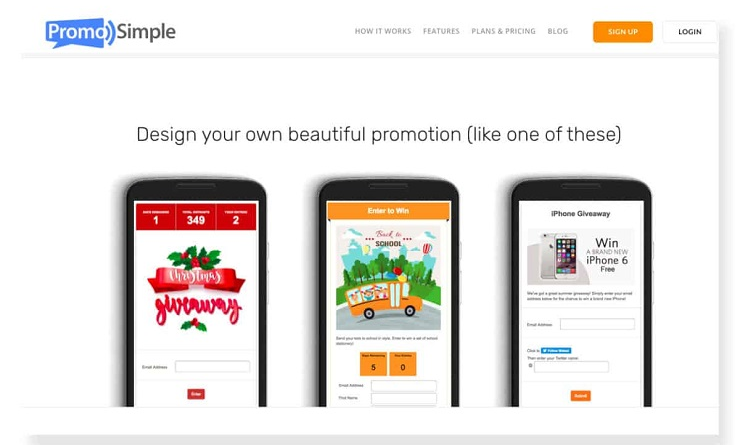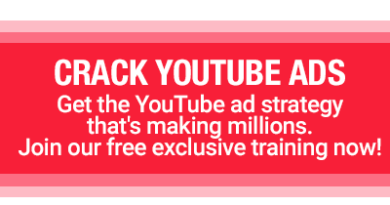How to Build a Huge Email List, Pre-Launch, Without Even Having a Website
It’s a paradox many new business owners face.
You’re supposed to start building your email list before you launch, but how can you attract leads to something that doesn’t exist, even online yet?
You’re basically saying, “Hey, sign up for my thing. I swear, it’s gonna be a thing!”
What if I told you the shaving brand Harry’s gathered 100,000 email addresses before its product was even ready for sale? I’ll explain how they did it below, but that’s just one case study of many that prove there are several ways to do email marketing without even a website—if you get creative.
So if you’re wondering how to build an email list without a website, below I break down five tactics you can try.
1. Host a Giveaway
If you want rapid list growth, giveaways are a great place to start. They work well for a few reasons:
- You’re able to offer something before your product is ready, and people love free stuff.
- The deadline-driven nature of giveaways lends a sense of urgency to your campaign.
- If you partner with influencers or other businesses, you can skyrocket the virality of a giveaway.
- Even if your own product isn’t ready yet, you can leverage partners’ products as prizes.
Still don’t believe this stuff works? Rafflecopter grew its email list from zero to 35,000 using its own giveaway software. Travel blog Who Needs Maps doubled its email list in seven days without spending a dime by partnering with brands to sponsor the giveaway prizes. Our very own Foundr landed 13,603 email signups in 10 days by holding a competition.
Finding a Giveaway Prize When You Don’t Have a Product
You’d be surprised how many businesses would be willing to provide their products as prizes for your giveaway. You just have to ask yourself, “What’s in it for them?”
Often, if you can prove to them that your giveaway will have an impressive reach (by sharing your current email list size or social media following, for example), you can get sponsors on board.
But if you’re reading this post, you probably don’t have a huge reach yet. So another tactic is to offer to share the email addresses you gather from the giveaway with the sponsoring business. If you do this, be sure to include in your giveaway terms and conditions that you will be sharing participants’ information with third parties.
How to Host a Giveaway When You Don’t Have a Website
Even if you don’t have a website, you can host a giveaway entry form using one of these sites:
They’ll host the giveaway on their platform, providing you with a link you can share or embed elsewhere.
Filtering Out People Who Signed Up Just for the Prizes
The great thing about using giveaways to grow your email list is that people love free stuff. But the bad thing about using giveaways to grow your email list is that…people love free stuff.
That means you’re probably going to attract a lot of people who only subscribed because they wanted to win the prize. That’s fine. All that means is you need to filter out those who aren’t really interested in your business.
Here’s how Mariah Coz of Femtrepreneur did it. After she launched her giveaway and gathered new email addresses, she kept the giveaway list separate from her main list. Because her target audience was business owners interested in webinars, the first email to her new list of giveaway subscribers had a strong call to action to unsubscribe if they weren’t interested in getting more emails about webinars.
After that, those who stuck with her list received three more emails that were part of the launch sequence promoting her online course on how to use webinars in your business. You can actually download her exact post-giveaway email sequence templates here.
2. Create a Simple ‘Coming Soon’ Landing Page
While building a full site for your business takes time, that doesn’t mean you can’t put up a simple landing page now that gathers email addresses before launch.
Remember our friends at Harry’s? The shaving brand launched in March 2013 to a whopping 100,000 email subscribers. Co-founder Jeff Raider breaks down how they did it on the Tim Ferriss blog.
In short, Harry’s created a two-page “microsite” with these elements:
- A splash page that said “Harry’s is coming” and asked for an email address so subscribers could be the first to know
- A second page had a referral rewards program. It contained a shareable link, and the more people they got to subscribe, the bigger the prize the entrant earned.
Raider makes no mention of paid advertising for their pre-launch microsite, so it sounds like the pure virality of the referral rewards program made word-of-mouth marketing their best friend for this pre-launch phase.
So how can you do something similar to what Harry’s did?
Step 1: Pick a landing page tool.
Tools like Leadpages and Instapage allow you to quickly put up a simple one-page site to capture email addresses without any technical know-how.
Step 2: Pick an email marketing service.
Some options include:
Because it’s free up to 2,000 subscribers, I recommend starting with MailChimp.
Step 3: Integrate your email marketing service with your landing page.
Now, you just need to link your email marketing service to your landing page. To figure out how to do that, search the helpdesk of your chosen landing page tool. Here’s a guide on how to link Leadpages with MailChimp.
Step 3.1 (Optional): Add referral capability.
To really skyrocket your list’s growth, you’ll want to build some virality into your landing page. One way to achieve this is to make a referral program where subscribers are rewarded for referring to other subscribers.
Now, Harry’s did this in a way that requires technical knowledge. If you’ve got that, you can take advantage of their pre-launch campaign page code in this post. If you don’t have a developer to help you, there’s an easier way. You can use KickoffLabs AnyForm integration to add a viral boost with referral tracking to Leadpages or Instapage.
Step 4: Share with your friends, family, and business connections.
To give your campaign an initial boost, personally email your friends and family and ask them to share. And if you have connections in your industry, email them too. This was a big part of the success that Harry experienced. Don’t be shy. You’ve gotta start somewhere.
The Easiest Way to Set Up a Quick Email Opt-In Landing Page
Now, if the above steps were a bit too much for you to handle right now, there is a much easier, cheaper, and faster way to set up an email opt-in landing page: your email marketing service.
If you chose MailChimp or Aweber, each one actually comes with built-in landing pages. These won’t be as customizable and won’t be able to handle referral programs, but they get the job done if you just need a place to send people to sign up for your email list.
Here’s what it looks like within MailChimp. You just go to Lists > Signup forms:
Then, select Form Builder, and you’ll be able to customize a signup form that creates a unique URL for you to use:
If word-of-mouth marketing doesn’t do the trick, consider investing in Facebook ads and other social media sites to drive traffic to your landing page.
3. Leverage Social Media
There are a few key ingredients you’ll need to start optimizing your social media profiles to grow your list. They’re the same ones Foundr used on Instagram to gain 30,000 subscribers in 30 days. What are they?
- An optimized profile. We made sure to include a link to our lead magnet in our bio.
- A killer lead magnet. We put together a massive 58-page ebook packed with tips to help you dominate Instagram.
- Calls to action in the captions. Not all of our Instagram posts were promotional, but the ones that were included a call to action telling followers to claim their free ebooks in the link in our bio.
- An awesome landing page. We kept it simple so that there weren’t any distractions preventing people from signing up for their free ebook.
Now, that’s just for Instagram. The same basic steps can be applied to any social media platform, whether that’s YouTube, Twitter, or even Pinterest.
How to Use Pinterest to Skyrocket Your List
Another social network I’d encourage you to try for list building is Pinterest. If you still think Pinterest is just a repository of pretty pictures for foodies and soon-to-be brides, think again.
Online marketer Melyssa Griffin used Pinterest to grow her email list to 40,000 subscribers in a year. Here are some basic strategies you can use to turn your Pinterest account into an email-list-building machine.
Step 1: Convert to a business account.
By converting to a business account, you’ll have access to analytics and the ability to promote pins (aka, run ads).
Step 2: Place target keywords in your name and bio.
Pinterest is a search engine, just like Google or YouTube, and yes, keywords count! Place a few target keywords in your bio to help potential customers find you.
Notice how Melyssa Griffin includes keywords like “entrepreneur” and “blogging tips.”
Step 3: Create boards that feature target keywords in the board title and description.
Again, Pinterest SEO is important. Unlike Google, so far it doesn’t seem that Pinterest penalizes for keyword stuffing, so feel free to put several target keywords in your board title and description.
Step 4: Join relevant group boards that your target audience would follow.
A great way to expand your reach is to join group boards. You can find group boards by using the search bar to type a keyword plus the word “group board.” Next, click the drop-down on the right side of the search bar and select “Boards.”
Click a board, and if you see multiple profile photos at the top right next to the board name, that’s a group board. In the description, the board owner will tell you how to join. Usually, you must email them, like this one:
Step 5: Create a vertical graphic that will link to your opt-in landing page.
I like to use Canva, which has a free option, to create pin images. Create a vertical image for your pin. Then, link that pin to your landing page. Don’t forget to add relevant keywords to the pin’s description.
Step 6: Pin it to relevant group boards to expand your reach.
Once you’ve pinned it to your own boards, pin it to relevant group boards. This expands your reach because when you pin to group boards, that pin shows up for the people who follow those group boards.
Because of Pinterest’s search engine-like qualities, your one pin can have a long shelf life, as people keep searching, finding, and pinning. It helps, though, to continually repin to your own boards and group boards. To automate this, you can use BoardBooster or Tailwind.
4. Guest Post on Popular Blogs
Guest posting can be a great way to get in front of a huge audience if you target the right blogs. And because you almost always can include at least one of your own links either in the post or in your guest author bio (or both!), you can leverage guest posting to grow your list. Gregory Ciotti used guest blogging to help grow Help Scout’s email list to more than 36,000 subscribers.
Where to Find Guest Posting Opportunities
- Your favorite blogs. If there’s an industry blog you follow, it could be a great place to start. You’re already familiar with their content, so you’ll know how best to craft a pitch for them.
- Google. Try searching “ guest posts,” “ write for us,” or “ submissions.”
- Pay attention to where you see guest posts on popular blogs. Even if a blog doesn’t put out an open call for submissions, you’ll notice many blogs publish posts that clearly state they’re from guest authors.
- Go with what your target customer reads. Overall, you’ll want to make sure to target a blog that has an audience of your target customers. Do some research and find out if these blogs accept guest posts. Now, some blogs will clearly state that they do not accept guest posts. If that’s the case, don’t pitch them. But if there’s no mention of guest posting at all, it doesn’t hurt to reach out to them anyway with your pitch.
How to Pitch a Guest Post
The biggest hurdle to overcome is that every blog gets dozens of spammy guest post pitches a week. Blog owners know that guest posting is a popular way for businesses to promote their products. And that’s fine, but the key here is to make sure the blog post you’re pitching offers true value to the blog’s readers and isn’t just a promotional piece for your upcoming launch.
In your pitch, be sure to:
- Follow any submission guidelines. If the blog has clear guidelines for guest authors, be sure you follow these.
- Get the person’s name and blog name right. You want to make sure they know you didn’t just copy and paste a generic template.
- Include one or two sentences about yourself and your business.
- Include a working title for the blog post and a bullet-point outline.
Once you’ve written your guest post, be sure to include the link to your email opt-in, either in your bio, in the body of the post, or in both places if the blog editor allows it.
5. Publish on Medium
Medium is like one large publication that houses several smaller publications. Through its unique discovery features, it helps users curate an assortment of stories catered to their interests. Users even get customized email roundups of the latest reads they might like. This is great news for you because it means you can access a huge number of targeted readers—for free.
Garin Etcheberry managed to get 160 email subscribers in just a few days thanks to Medium. He wrote an article about how he landed dream jobs by giving away his best ideas. It made Medium’s Top 20 Most Recommended Articles of the Day list, garnering more than 10,000 views within a couple of days. Let’s break down how he set up his Medium post for success:
- His Medium post’s title and content were intriguing.
- The content was tailored to his ideal audience.
- He added it to a Medium publication.
- He mentioned big names (such as James Altucher) and tweeted the article to them.
- He included calls to action and lead magnets to get readers to subscribe.
How to Create a Medium Account
1.Go to Medium.
You can create a free account with your Google or Facebook account.
2. Customize your interests.
Pick topics related to your business and target audience so Medium can recommend stories and publications for you.
3. Optimize your profile.
Be sure to add a headshot, a short bio, and a link to your email opt-in form. In fact, you can add more than just one link to your bio. Check out how Stephen Cognetta does it:
How to Optimize Your Posts on Medium
- Request to join publications. Publications are like magazines; they have multiple contributors and often accept submissions. The advantage to submitting your piece to a publication is that it can expand your article’s reach to a larger audience.To find relevant publications, just click on your profile photo in the upper right corner and select Publications. These are publications Medium has curated for you based on your interests:
- You can also use a tool like Smedian to find publications and request to contribute to them.
- Add relevant tags. Much like hashtags on Instagram, tags on Medium help users find relevant content to read. You can add up to five tags to each of your articles, so make them count!
- At the bottom of each post, include a call to action and a link to your lead magnet or email opt-in.
Booming Email List, Pre-Launch, No Website Needed
See? Even if you don’t have a blog and even if you haven’t launched anything yet, you can still grow your email list. To recap, here are the best ways to build an email list without a website:
- Host a giveaway.
- Create a simple landing page.
- Leverage your social media accounts.
- Guest post on popular blogs.
- Publish on Medium.
Follow these tips and instead of launching to crickets, you’ll come storming out of the gates with a ton of potential customers eager to hear about what you have to offer.
What other creative ideas have you used to build your list?



